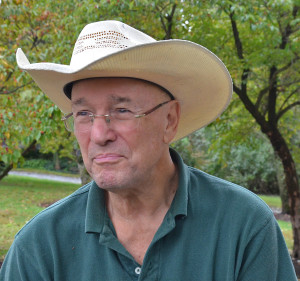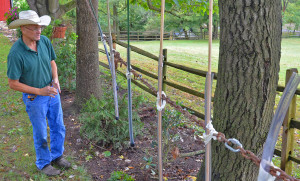Lovettsville’s Rick Peck, the 6th grade science teacher at Seneca Ridge Middle School in Sterling, Virginia is a passionate, endearing, latter day pied piper, leading his young pupils into the frontiers of the mind like the not so long ago popular TV personality, Don Herbert, more widely known as “Mr. Wizard.”
Like the original Mr. Wizard, Rick has earned a deserved reputation as “the friendly, neighborly scientist.”
I met Rick at the height of his homestead’s rolling hills, by an old-fashioned red country barn.
Rick was puzzling how to straighten 14 hollow plastic tubes slightly curved to use at his 6th grade Monday science class.
Dodging a cloud of no-see-ems, Rick manipulated the tubes, “deformed” by slight arcs, because his intended lesson on fluid density required the students to pour less dense fluids over heavier fluids, without spilling a drop, and then Rick would suggest to the class a last addition to the experiment, a surprising touch of chemical legerdemain, that would disrupt the layered quiescence, guaranteeing the attention and curiosity of his students.
It’s little wonder that Rick is in contention from the Commonwealth to receive a presidential award for excellence in mathematics and science teaching given his devotion to instructing young minds.
“Whomever is elected President,” said Rick, “will be presenting the award. I would enjoy receiving this honor should it be conferred.”
The keen competition for science and math teachers says something quite wonderful about how well we are educating our young, and Rick stands out among these worthy teachers.
Among Rick’s innovative experiments was a collective undertaking, requiring all 109 6th graders to study the power actually used in the West Wing where the 6th graders studied at the Seneca Ridge Middle School, by installing an electrical sub meter in the Wing’s electrical distribution box.
The software Rick used showed the instantaneous kilowatt demand, visibly updated, minute by minute, and each kilowatt hour was calculated to be the equivalent of 1.1 kilograms of spent carbon dioxide, thus quantifying the West Wing’s carbon footprint.
The changing and cumulative results were continuously broadcast on a monitor in the student’s main locker area.
When Rick first asked the students if they could do anything to reduce greenhouse gasses, most said “no way.”
“We showed the power usage, and how it changed,” Rick said, “in one instance, by turning off all the power to the West Wing, ‘power[ing] down,’ so the students could see how power consumption dropped. We turned on 550 watt hot plates, and the students saw how the demand ‘spiked.’ When we asked in a ‘Town Hall’ of all the 6th graders, whether anything could be done to conserve energy, the students’ opinions flipped, and they thought something could be done, and more thought they could make a change. In response to the study, the students recommended that we take out light bulbs. 92 light bulbs were disabled for a saving of 27 kilowatt hours. We asked the students in a survey what they thought about climate change, and could they make a difference. The number doubled who felt they could.”
In another assignment, Rick showed the same imagination, assigning the essay, “A day in the life of a water molecule,” a colorless, tasteless, solvent, used so extensively, it is considered the solvent of life, and can exist in different states, not just liquid, but also as a gas, and an icy solid.
“The students wrote of the bond that holds the elements together,” Rick said, “and of the tension that exists, like it was a family, between the Hydrogen and Oxygen elements, dependent on each other. They won’t soon forget what they learned.”
Rick truly is a “wizard” in the sense that he is especially good and innovative as a teacher, and the bonus for our young is that he’s not alone in his devotion.


